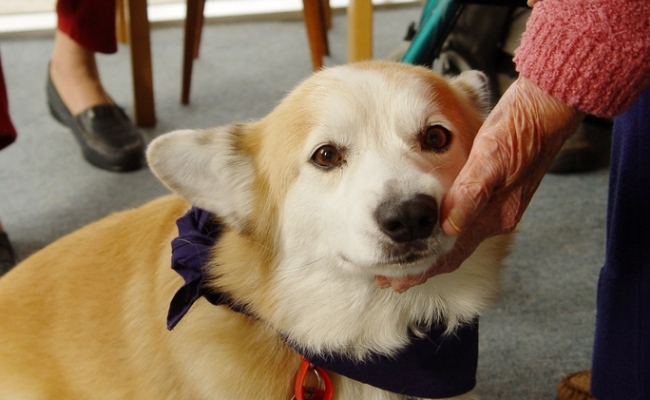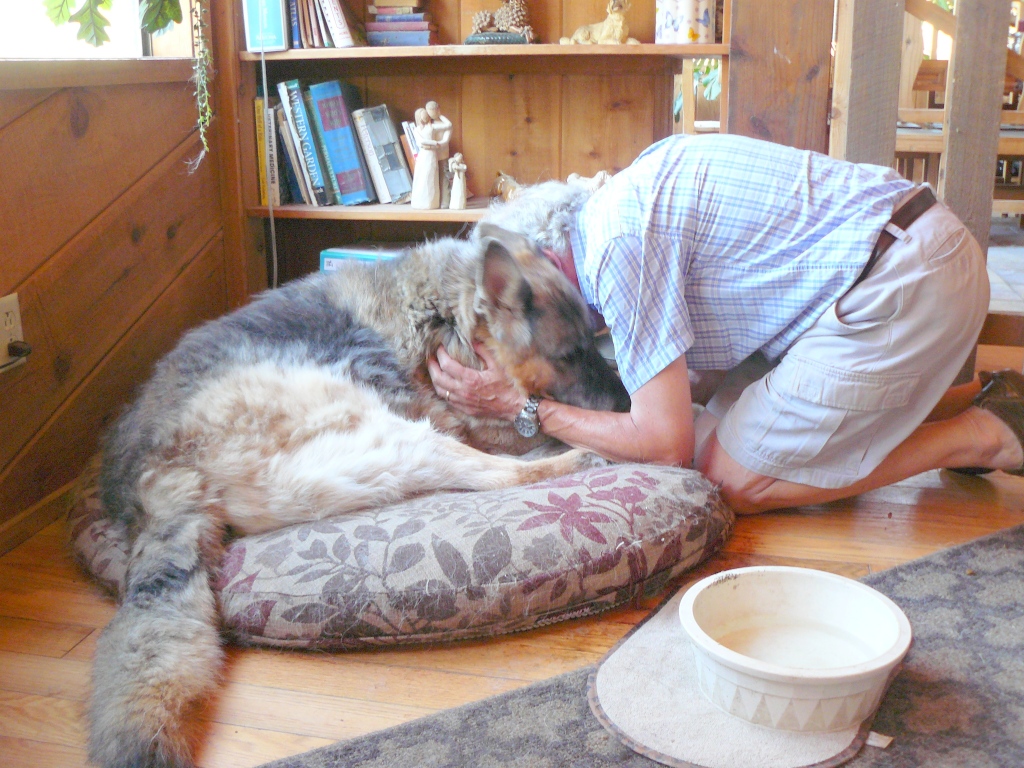The huge gift we receive from therapy animals.
I know there are times when giving Brandy a big hug feeds something very deep inside me. That unconditional affection Brandy shows me has a very strong healing sense.
I know that Jean shares my sense of being loved by Brandy, and by all our other dear dogs.
I am without doubt that hundreds of thousands of other people experience this.
Yet there must always be room for more therapy dogs which is why an item on Care2 just a few days ago is being shared with you today.
(P.S. When a photo of me hugging Brandy was sought his nibs did not comply!)
ooOOoo
Could Your Pet Become a Therapy Animal?
If you have a pet who’s mellow and loves being around people, and the idea of helping your pet bring joy to others appeals to you, you might just have a therapy animal in the making.
Accompanied by their owners, therapeutic visitation animals – which are most commonly dogs, but can also be cats, rabbits, pot-bellied pigs, horses, etc. – regularly visit people in hospitals, nursing homes, schools and other facilities, providing furry comfort and compassion.
“Four-footed therapists give something special to enhance the health and well-being of others,” says the website of Therapy Dogs International (TDI), a nonprofit organization that regulates, tests and registers therapy dogs and their handlers. “It has been clinically proven that through petting, touching and talking with animals, patients’ blood pressure is lowered, stress is relieved and depression is eased.”
What It Takes to Be a Therapy Animal
Therapy animals are “born, not made,” according to TDI. They must have an outstanding temperament, and be outgoing and friendly to people of all ages. They must also behave well with other animals.
As for dogs, along with the ability to obey basic commands like “Sit,” “Stay,” “Come” and “Leave it,” they are tested by therapy dog certification organizations to ensure they can do the following, according to TDI (most of these requirements apply to other species of potential therapy animals as well):
- Listen to their handlers
- Allow strangers to touch them all over
- Not jump on people when interacting
- Not mind strange noises and smells
- Be calm for petting
- Not be afraid of people walking unsteadily
Getting Your Pet Certified as a Therapy Animal
Think your pet has the right stuff to be a therapy animal? To get an idea of the type of testing involved, this TDI brochure describes each of the 13 tests a dog must pass in order to be certified. The tests are similar for other animals.
Some therapy animal organizations, including Pet Partners, offer workshops so you and your pet can practice the required skills before being tested for certification.
The AKC website has a list of therapy animal organizations all across the U.S. from which your pet can receive certification. Contact the one nearest you for further information.
The Difference Between Therapy and Service Animals
Although the two are often confused, therapy animals are not the same as service animals, which “have been individually trained to do work or perform tasks for the benefit of a person with a disability,” according to the Americans with Disabilities Act (ADA).
“An example of a service dog is a dog who guides an owner who is blind or assists someone who has a physical disability,” the American Kennel Club (AKC) explains. “Service dogs stay with their person and have special access privileges in public places such as planes, restaurants, etc.”
Therapy dogs, on the other hand, are privately owned. Unlike service animals and their handlers, in most U.S. states, therapy animals and their owners don’t have protections under federal law (ADA, the Fair Housing Act, etc.), reports the National Service Animal Registry.
Additional Resources
You can find out more about therapy animals and getting your pet certified from these organizations:
Photo credit: Thinkstock
ooOOoo
Closing this post with some photographs Jean took yesterday afternoon. Me with Pharaoh and Cleo.
(OK, they were staged for this post as the look on Cleo’s face rather suggests!)





I love the idea of therapy animals 🙂
My animals haven’t the needed potential, but I’m happy that many others have.
LikeLike
Both the formal ones, and the informal ones that thousands of dog lovers enjoy. Your animals, I would bet, certainly offer the latter for you. Have a great weekend.
LikeLiked by 1 person
You are right Paul, they are just not so social to be therapy dogs, only at home and here they do a great job 🙂
Wish you a happy weekend.
LikeLike
And the same to you and yours.
LikeLiked by 1 person
Thank you 🙂
LikeLike
Love the photos Paul. I get so much from hugging and cuddling my 2 dogs and 4 cats – even the dogs at my neighbour’s house. The 12 year old lab/ retriever that we recently rescued from years by himself in an isolated backyard in Melbourne’s west, where he was never walked and only visited briefly 4 times a week to be fed and watered, shows his love and gratitude to us every day – maybe much like Brandy. He radiates happiness from the attention and affection that he now receives and that makes us feel so good.
LikeLike
Marg, your fabulous contribution radiates precisely how your dogs and cats make you feel. Remind me of the name of your lab/retriever? (Better still send me a guest post and some pictures!)
LikeLike
There is nothing better than having an animal to hug and/or pet whether it’s a dog, cat, horse, pig, chicken, or whatever. I don’t have a clue about the dynamics but maybe it’s simply that humans and animals have a need for touch. The effect is mutually beneficial of course and I think I read that beneficial endorphins are released.
I wish there were more therapy dogs for nursing homes and the like. When I see my sis everyday in the nursing home I see the saddest looking faces of the residents. It really distresses me. It should not be that way. Those folks have nothing to stimulate their desire to live or to interact if there is non family that visits on a regular basis.
The pics of you hugging Pharaoh are priceless.
LikeLike